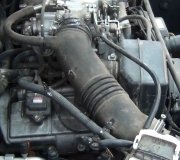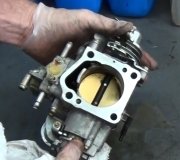This is a really old post, but of course I feel the need to add my comments of great value. The intent of this system is to cool the air so it contracts and more oxygen goes into the cylinders. Of course more fuel is needed to go with it, so it falsely appears you got more power. The rest of us do that by pushing further on the accelerator pedal, and we get the same thing. Intercoolers are used with many turbochargers because compressing the air packs all its heat into a smaller space which causes the temperature to go up. The incoming air cools the intake valves. Failing to cool that air can lead to burned valves, and it can cause pre-ignition in gas engines. Intercoolers get the air temperature back down to normal ambient air temperature, not colder than normal.
Also keep in mind liquid gas and liquid diesel fuel will not burn. In fact, if you throw a lit match into a pan of liquid fuel, that fuel will put the match out. Fuel must be in vapor form to burn. That is the purpose of the intake system, to warm the fuel and/or warm the air to help the gas turn to a vapor before it gets to the intake valves. Why would you want to put on a system that attempts to defeat that? Any gas that remains a liquid goes out the tail pipe, wasted. When we had carburetors, we needed a choke to force way too much fuel to be dumped into the cylinders in hopes a high enough percentage would vaporize for the engine to run right. Once the exhaust system warmed the intake runners and base of the carburetor enough for the gas to vaporize on its own, the choke was no longer needed. You are trying to get the air back to where a choke was needed. The engine computer will see the readings from the intake air temperature sensor, and it will command more fuel in the same way the choke used to do.
My 2014 four wheel drive 1500 truck can cruise all day long on a flat highway and stay between 22 and 24 mpg. Average driving around Wisconsin is 19.2 mpg with tons and tons of power to pass people when necessary. It has no gimmicks or modifications, so your 16 mpg is nothing to be proud of.
I have a friend with a body shop who specializes in rebuilding smashed one and two-year-old Dodge trucks for about fifty regular customers in his rural farming community. He loves his diesels, and in fact, he does have an aftermarket air filter system on the last one he built for himself, but he did that because it can be washed out easily rather than having to replace it all the time. He increased his fuel mileage by using a "chip", or add-on computer module which I do not know much about. He claims to have increased fuel mileage by four miles per gallon, and towing power has gone way up. Apparently they do not do that at the factory because they would tear up too many automatic transmissions. This is quite different though than with gas engines. Diesel engines do not have throttle blades. They are wide open to suck in as much air as possible, then engine speed is controlled by the amount of fuel that is sprayed in. Fuel/air mixture ratio varies a lot and is not a factor in performance like it is with gas engines. With your engine, as was stated previously, you still need the 14.7/1 air/ fuel ratio for best power and lowest emissions. If you modify something to make it run lean, fuel mileage might go up, but performance and emissions will suffer. Performance cannot help but go down when there is less fuel. Your engine does not make power by burning extra air. As was stated previously, if the engineers at Ford could have increased power and performance without sacrificing emissions or durability, they surely would have done it. The world of automotive marketing is so extremely competitive, if they could advertise one more inch of leg room, one more cubic foot of cargo space, one more pound of load-hauling capacity, one more mile per gallon, or especially one more cup holder, you can be sure they would have done it. There is a reason they did not, and you or I are not going accomplish what the highly-trained engineers could not do.
Tuesday, April 24th, 2018 AT 1:06 PM


